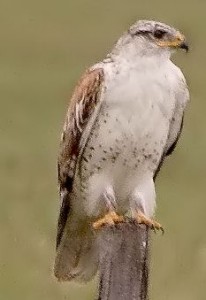The Ferruginous Hawk, largest of North American buteos, is a bird of the open spaces of the western Great Plains and Great Basin. The primary prey items of this raptor are rabbits, ground squirrels, and prairie dogs. The fluctuating status of these species, along with changes in agricultural and range management practices and parkland expansion, have had significant and long-term effects on the distribution and status of the Ferruginous Hawk throughout its range.
Almost nothing is know about migration of individual Ferruginous Hawks in the southern portions of its breeding range: The birds may be sedentary or migrate only short distances (Bechard and Schmutz, 1995). For this reason, in some areas of the Panhandle it is not known whether those hawks first seen in fall are in fact long-distance migrants or birds that have shifted from their nesting grounds in the northwestern and western counties.
DISTRIBUTION: The TBBA atlasers found all summering Ferruginous Hawks north of the 34th parallel in the Staked and Pecos Plains and Red Rolling Plains. Confirmations of nesting were made in Dallam and Moore counties, and probable or possible nesting in Bailey, Deaf Smith, Hartley. Hutchinson and Randall cos.
A sighting of a single bird in latilong 26093 in the South Texas Brushlands (Agua Nueva quad, Jim Hogg County), though classified possible, probably did not represent nesting in progress. The Ferruginous Hawk has never been reported breeding in Texas south of the 31st parallel in the Osage Plains (Oberholser, 1974, Lockwood and Freeman 2004).
The species nests from southernmost Canada (Alberta, Saskatchewan, Manitoba) south to Arizona, New Mexico, and northwest Texas.. Its winter range extends southward into Mexico and the central and south coastal plains of Texas (Bechard and Schmutz 1995, Howell and Webb 1995).
SEASONAL OCCURRENCE: The breeding season of the Ferruginous Hawk in Texas lasts from March to July The earliest nest-building observed is March 15; the four eggs in the nest noted on April 22 hatched within week, and were probably laid no later than the last week of March. The latest date for leaving the nest is June 26; latest fledglings is July 7. This compares to nest-building in mid-latitudes (e.g.,Colorado and Utah) in early to mid-March (Bechard and Schmutz, 1995). Oberholser (1974) names breeding from April to July (eggs May 6-June 2). Almost all confirmations, made during the TBBA field work (1987-1992), pertain to nests containing young found in June.
The first discernible migratory movement occurs around mid-September, and most Ferruginous Hawks have departed northward by mid-March.
BREEDING HABITAT: The Ferruginous Hawk uses a variety of substrates for nesting, not only natural ones (trees, cliffs, relatively level ground) but also man-made structures (windmills, utility poles, farm buildings, haystacks). In recent years artificial nesting platform programs have been initiated (Schmutz et a!., 1984). Such a program started in the Oklahoma Panhandle (Rita Blanca National Grassland (NG) in 1989 held six nesting pairs of hawks in 1991 (Schwarz, 1991). This hawk usually avoids nesting near areas of recent agricultural cultivation (Bechard and Schmutz, 1995). In northwest Texas it is found in grassland and sagebrush country.
The Ferruginous Hawk may occupy a nest site over a lengthy period of time. Such a site (three isolated trees in a sea of grassland), first discovered on the Rita Blanca NG in Dallam Co. in 1975, has since been occupied almost yearly. How long the site had been utilized prior to its discovery is unknown, for at the time the nest was quite large and bulky (KDS). Another site on the Muleshoe National Wildlife Refuge (NWR) in Bailey Co. was occupied 1965-73 (fide C. Stogner). The Dallam Co. nest, refurbished yearly, was rebuilt twice upon its having collapsed through bulk and weight. On the last occasion a pair of Swainson’s Hawks was first to reoccupy the site, only to be ejected in a later year by a Ferruginous pair.
The female usually lays 2-4 (range 1-8) creamy white eggs (see Harrison [1979] for photo of markings) in the large nest. which are incubated for about 32-33 days. The young birds typically leave the nest 38-50 days after hatching (Bechard and Schmutz 1995).
STATUS: Agricultural development and widespread elimination of the prairie dog are factors that have had significant adverse effects on the breeding status of the Ferruginous Hawk. Early in the century Strecker (1912) found this hawk breeding “abundantly” in the Panhandle (Potter and Armstrong cos.), while others (Hibbets et a!.1926-36) considered it a “numerous” permanent resident. By mid-century several observers spoke of a decline: Stevenson (1942) reported “a few nest in the canyons”, Allan and Sime (1943 ) said only 17 recorded in 5,003 miles traveled; Hawkins (1945) foiund it a “rare summer resident”, no conclusive evidence of nesting.
In recent years confirmed nesting has been confined to northwestern counties(Dallam, and Moore). The only other counties reporting nesting in the 1990s are Ochiltree (1995) and; Oldham (1996);
While the loss of grasslands to agriculture has contributed to the decline in the nesting status of the Ferruginous Hawk in Texas, such land conversion has not had a like effect on the species’ winter status. A 10-county study (Schmutz, 1987) revealed this hawk foraging intensively in irrigated and cultivated regions where small rodents were abundant. They estimated 18% of all grassland Ferruginous Hawks winter in this small area of Texas.
This hawk is currently listed as a Category 2 Species by the U.S. Fish and Wildlife Service and as a Sensitive Species by the Bureau of Land Management. A petition to list the Ferruginous Hawk under the federal Endangered Species Act in 1991 was rejected (USF&WS, 1992).
Lockwood and Freeman (2004) describe this hawk as a rare summer resident in the central and western Panhandle and a common to locally uncommon winter resident in the High Pains and Trans-Pecos regions.
Allan, P. F. and P. R. Sime. 1943. A hawk census on Texas Panhandle highways. Wilson Bull. 55: 29-39.
Bechard, M. J. and J. K. Schmutz. 1995, Ferruginous Hawk (Buteo regalis). In The Birds of North America, No. 172 (A. Poole and F. Gill, eds.). The Birds of North America, Inc., Philadelphia, PA
Harrison, H. H. 1979. A field guide to western birds’ nests. Houghton Mifflin, Boston, MA.Hawkins, A. S. 1945. Bird life of the Texas Panhandle. Panhandle Plains Hist. Review XVlll:1 10-150.
Hibbets, A. I., L. A. Saunder, and D. Walker. 1926-36. Birds seen along creeks, in canyons, or on plains within forty miles of Canyon, Texas. West Texas A&M University Library. Canyon. 9 pp.
Howell, S. N. G. and S. Webb. 1995. A guide to the birds of Mexico and northern Central America. Oxford University Press, New York.
Lockwood, M. W. and B. Freeman. 2004. The TOS handbook of Texas birds. Texas A&M University Press, College Station.
Oberholser, H.C. 1974. The bird life of Texas. Univ. Texas Press. Austin.
Schmutz, J. K. 1987. Population size, distribution and survival of Ferruginous Hawk in n.w. Texas. University of Saskatchewan. Saskatoon. 36 pp.
Schmutz, J. K., R. W. Fyfe, D. A. Moore and A. R. Smith. 1984. Artificial nests for Ferruginous and Swainson’s hawks. J. Wild!. Manage. 48: 1009-1013.
Schwarz, H. R. 1991. National grasslands breeding bird report for 1991. Cibola National Forest. Albuquerque, NM. 20 pp.
Stevenson, J. O. 1942. Birds of the central Panhandle of Texas. Condor 44:108-115.
Strecker, J. K., Jr. 1912. The birds of Texas: an annotated check-list. Baylor University Bull. 15(1).
U.S. Fish and Wildlife Service. 1992. Endangered and threatened wildlife and plants; notice of finding on petition to list the Ferruginous Hawk. Federal Register 57(161):37507-37513.

